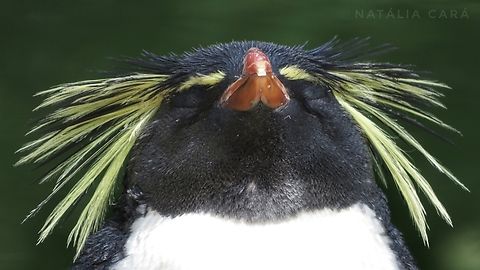
Appearance
The rockhopper penguin was split into three distinct subspecies in 1992; the southern, eastern and northern rockhopper penguin. The three subspecies are distinguished by differences in the length of the tassels of the crests, the size and colour of the fleshy margin of the gape, colour pattern on the underside of the flipper and differences in the size of the superciliary stripe in front of the eye. Additionally, the northern rockhopper penguin is larger than the other two subspecies. Proof that the three subspecies were truly different, in terms of more than reproductive isolation and some morphological features, was found in the mitochondrial sequences of the three species. It was found "E. c. filholi" and "E. c. chrysocome" were not as different genetically as "E. c. moseleyi" was to the other two subspecies. The level of genetic differentiation was similar to the genetic difference found in other penguin subspecies groups.Another way that scientists were able to differentiate the different subspecies of rockhoppers were in the parasites that fed off each separate rockhopper penguin species. Penguins are parasitised by 15 species of chewing lice in two genera, "Austrogoniodes" and the monotypic "Nesiotinus". Within rockhopper penguins, the host-specific louse "Austrogoniodes keleri" is present only on southern rockhoppers; the multi-host "Austrogoniodes concii" parasitises only northern rockhoppers and "Austrogoniodes hamiltoni" parasitises only eastern rockhoppers. Cross contamination of the lice is not possible naturally due to the fact that chewing lice have limited mobility and heavily rely on their host for survival, meaning that the lice can only be transmitted across species by way of close physical contact.
Distribution
More than 99% of northern rockhoppers breed during late spring or early summer on Tristan da Cunha and Gough Island in the south Atlantic Ocean. Breeding colonies are also found on the French Southern and Antarctic Lands of Amsterdam Island and St Paul Island.The current population is estimated to be between 100,000–499,999 breeding pairs at Gough Island, 18,000 to 27,000 pairs at Inaccessible Island, and 3,200 to 4,500 at Tristan da Cunha. In the Indian Ocean, the population was 25,500 pairs on Amsterdam Island, and 9,000 pairs on St Paul Island in 1993; there has been no information available on population trends there since the 1990s. Declines at the Atlantic Ocean sites show a decline of 2.7% per year; the drop in the population at Gough Island has been described as equivalent to the loss of 100 birds every day since the 1950s.A study published in 2009 showed that the world population of the northern rockhopper had declined by 90% since the 1950s, possibly because of climate change, changes in marine ecosystems and overfishing for squid and octopus by humans. Other possible factors in the decline include disturbance and pollution from ecotourism and fishing, egg-harvesting, and predation and competition from subantarctic fur seals. Surveys show that the birds are at risk of infection by goose barnacles. House mice have been introduced into their environment by human sea expeditions. The mice have proven to be invasive, and consume northern rockhopper eggs, as well as hunt their young. In order to preserve the birds, a culling of the mice is being considered. The climate change conditions alter food availability since it reduces nutrients and productivity. This causes an effect on the body mass, causing a negative impact on their reproductivity success.
The northern rockhopper penguin is classified as endangered because of the decline in numbers over the last three generations.
Population Trends by Year and Island
Status
A study published in 2009 showed that the population of the northern rockhopper had declined by 90% since the 1950s. For this reason, the northern rockhopper penguin is classified as endangered.Habitat
More than 99% of northern rockhoppers breed during late spring or early summer on Tristan da Cunha and Gough Island in the south Atlantic Ocean. Breeding colonies are also found on the French Southern and Antarctic Lands of Amsterdam Island and St Paul Island.Reproduction
It breeds in colonies in a range of locations from sea level or on cliff sides, to sometimes inland. The Northern form, found in Amsterdam and Gough island, is reproductively isolated from the Crozet and Kerguelen islands. They are monophyletic; meaning they have a split in the mitochondria DNA trees which forms two subspecies: the northern and southern rockhopper penguin. Another interesting difference between the two subspecies is their mating ritual. They both use different songs and head ornaments in their mating signals. The reproductive isolation has led to not only physical difference but also behavioral. The adults feed their chicks lower trophic level prey than they themselves consume. During breeding season the adults eat zooplankton and then transition to fish, showing they favor future reproduction.Food
The northern rockhopper penguin feeds on krill and other sea life such as crustaceans, squid, octopus and fish.References:
Some text fragments are auto parsed from Wikipedia.